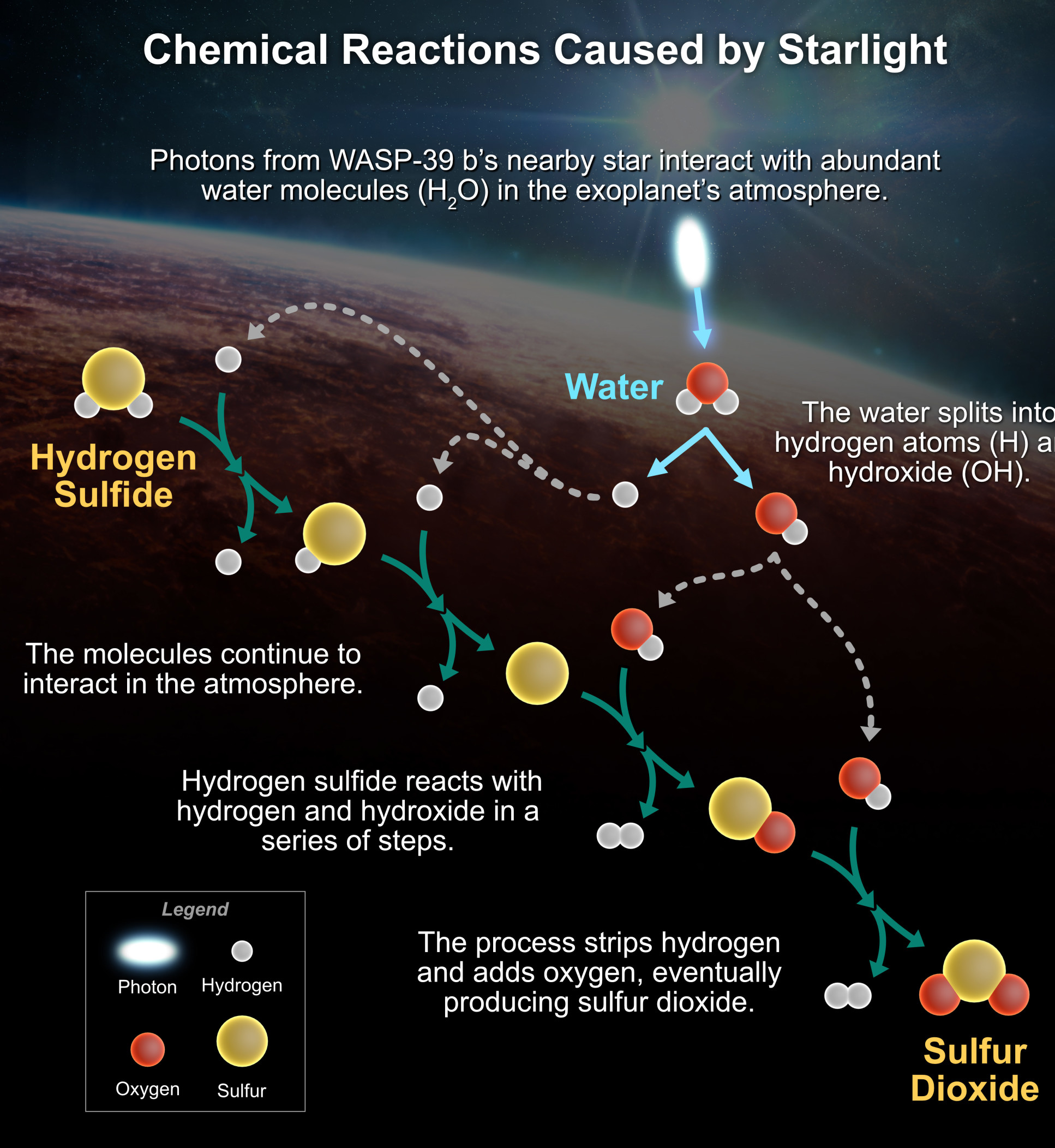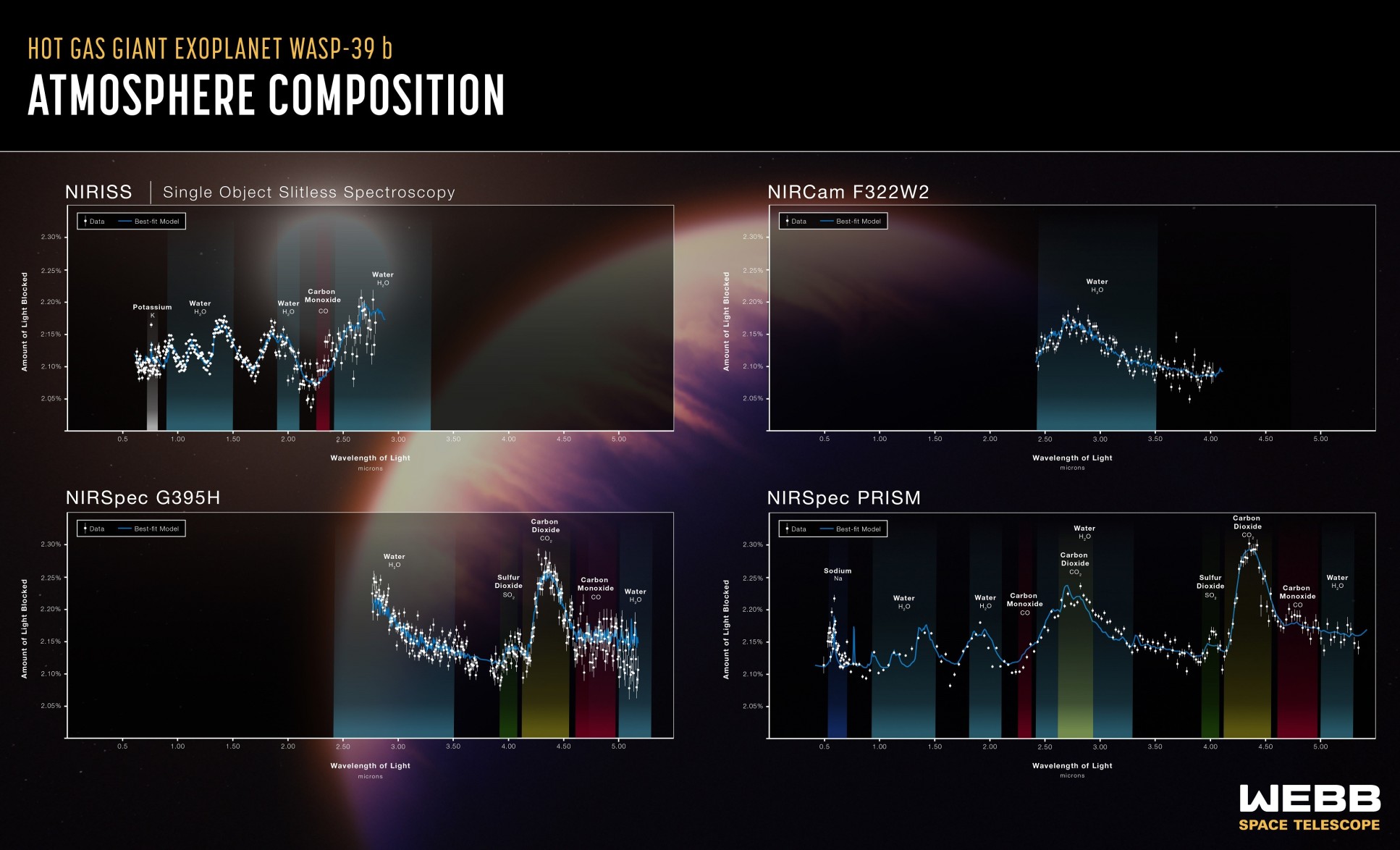Studies of one exoplanet’s atmosphere using James Webb Space Telescope instruments have revealed the detection of new molecules and cloud structures.
In a suite of studies across five papers, a large international team including Imperial College London researchers has demonstrated the power of the James Webb Space Telescope (JWST) for investigating exoplanets.
The level of detail provided by JWST is revolutionary. It is incredibly exciting to think that we’re only at the dawn of the JWST era. Dr James Kirk
The telescope was used to investigate the atmosphere of the exoplanet WASP-39b, a gas giant planet orbiting a star 700 light-years away. WASP-39b is extremely ‘puffy’ – it has a radius a little larger than Jupiter, but less than half the mass. This means there is a lot of atmosphere for researchers to study.
The JWST, which launched on Christmas Day 2021, conducts infrared astronomy and is the successor to the Hubble Space Telescope. It carries several types of sensing instruments, including the Near InfraRed Spectrograph (NIRSpec), the Near InfraRed Camera (NIRCam) and the Near InfraRed Imager and Slitless Spectrograph (NIRISS), which were used for the new studies.
The measurements of WASP-39b are taken when the planet passes in front of its star, with the starlight shining through its atmosphere providing the instruments with lots of detail about the chemical makeup and structure of the atmosphere.
Atmosphere insights
In August 2022, it was announced that one of the instruments had detected carbon dioxide in WASP-39b’s atmosphere, the first time this molecule had been detected in an exoplanet’s atmosphere. The new data, across a whole suite of instruments, also reveals the first detection of carbon monoxide in WASP-39b’s atmosphere, as well as the first detection of sulphur dioxide in any exoplanet atmosphere.
The team discovered that the sulphur dioxide is produced by photochemistry – chemical reactions catalysed by starlight. This is the first time a photochemical by-product has been detected on an exoplanet. Photochemistry is fundamental for life on Earth, from the production of ozone in the upper atmosphere to photosynthesis in plants and algae to the production of Vitamin D in our skin.

The process used to identify these new molecules, alongside the previously discovered water, sodium and potassium, also gives researchers an early peek at elemental abundance ratios, which compare the proportion of two elements.
These measures, such as carbon-to-oxygen and potassium-to-oxygen ratios, can give researchers information about how the planet formed out of the disk of gas and dust surrounding the parent star in its younger years.
The studies also reveal evidence of non-uniform cloud cover in WASP-39b’s atmosphere, potentially in a similar way to clouds on Saturn and Jupiter.
Dramatically improving our understanding
The new papers were led by PhD students Zafar Rustamkulov at Johns Hopkins University, Lili Alderson at the University of Bristol, Eva-Maria Ahrer at the University of Warwick, Adina Feinstein at the University of Chicago, and Shang-Min Tsai at the University of Oxford.
Imperial College London’s Dr James Kirk, from the Department of Physics, was a key member of the NIRSpec PRISM team, providing independent analyses of the data using software he wrote himself.

The instrument works by measuring the brightness of the star as it changes over the time during which the planet passes in front of it. This results in around 21,500 measurements over an eight-hour period. Dr Kirk’s software fits these brightness measurements with planetary models to generate a light spectrum and reveal the atoms and molecules present in the planet’s atmosphere.
In this way, he was one of the first people to produce results for the planet’s atmospheric composition. He said: “I was blown away when I first saw the planet’s spectrum. I knew we had something remarkable, in terms of the level of structure that was in the spectrum and the precision we achieved.
“The level of detail provided by JWST is revolutionary. It is incredibly exciting to think that we’re only at the dawn of the JWST era.”
The NIRSpec PRISM data showed clear detection of sodium, water, carbon dioxide and carbon monoxide, and hinted at the presence of sulphur dioxide, which was confirmed by one of the other instruments.
The instruments measure different aspects of the spectrum with some overlap at the margins, allowing researchers to check they are producing the same results, which was proven for this suite of instruments.
Dr Kirk added: “The studies show that JWST is working exceptionally well and so will dramatically improve our understanding of the atmospheres of both gas giants and potentially habitable exoplanets.”
-
Top image credit: Melissa Weiss/Center for Astrophysics | Harvard & Smithsonian
Paper details:
- Early Release Science of the exoplanet WASP-39b with JWST NIRSpec G395H (Alderson et al.)
- Early Release Science of the exoplanet WASP-39b with JWST NIRSpec PRISM (Rustamkulov et al.)
- Early Release Science of the exoplanet WASP-39b with JWST NIRCam (Ahrer et al.)
- Early Release Science of the exoplanet WASP-39b with JWST NIRISS (Feinstein et al.)
- Direct Evidence of Photochemistry in an Exoplanet Atmosphere (Tsai et al.)
Article text (excluding photos or graphics) © Imperial College London.
Photos and graphics subject to third party copyright used with permission or © Imperial College London.
Reporter
Hayley Dunning
Communications Division

Contact details
Tel: +44 (0)20 7594 2412
Email: h.dunning@imperial.ac.uk
Show all stories by this author
Leave a comment
Your comment may be published, displaying your name as you provide it, unless you request otherwise. Your contact details will never be published.




Comments
Comments are loading...